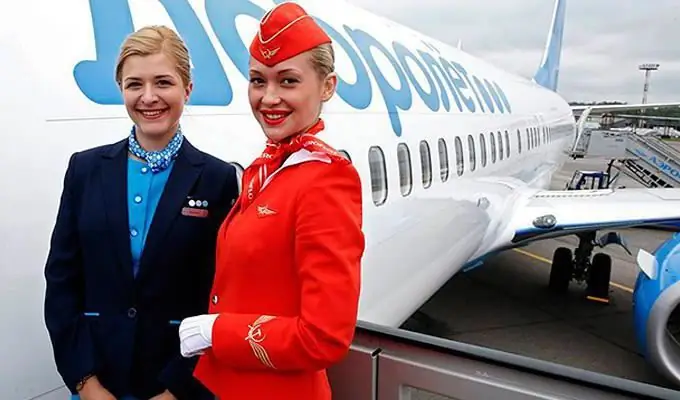- Author Harold Hamphrey [email protected].
- Public 2024-01-02 09:46.
- Last modified 2025-06-01 07:20.
How fast do passenger planes fly? Everyone who has flown in an airplane knows that during the flight, passengers are always informed about the speed of the aircraft. Different types of aircraft have different speeds in different conditions. Let's take a closer look at this interesting question.
Classification of aircraft by speeds
Today, it has become customary to measure the speed of aircraft with the speed of sound. The speed of sound in air is 1,224 km/h. Based on the correspondence of the speed characteristics of the aircraft to the speed of sound, all aircraft are classified as follows:
- subsonic - fly at speeds below the speed of sound;
- supersonic - fly at speeds exceeding the speed of sound (speaking of speeds commensurate with the speed of sound, they use the concept of "transonic" or "subsonic");
- hypersonic - exceed the speed of sound 4 times or more.
All passenger ships are classified as subsonic, as they fly at speeds that usually do not exceed the speed of sound.
And yet in the history of civil aviation there was an experience of using supersonic passenger aircraft.
The legendary past of supersonic civil aviation: Tu-144 and Concorde
Revealing the question of how fast passenger planes fly today, one cannot fail to mention the supersonic passenger planes of the past - Tu-144 and Concorde. These two legends of world aviation saw the light almost simultaneously.
The best minds of the Soviet Union worked on the creation of the ultra-high-speed "Tu-144". It made its first test flight in late 1968.

The Concorde was the brainchild of the Franco-British Union of Aircraft Designers. He first took to the skies in early 1969.

Both planes looked very similar to each other. The speed of the Tu-144 was 2,300 km/h, the speed of the Concorde was 2,150 km/h.
A significant drawback of both aviation monsters was the unbearable noise during the flight, emanating from the engines and air conditioning.

The first accident with the Tu-144 occurred in 1973 at the international air show Le Bourget in France. The plane crashed to the ground during a test flight. The exact cause of this disaster remains unknown. In 1978 there was a second crash - inIn the Moscow region, during the control and acceptance flight, the side of the aircraft caught fire. The pilots managed to land the car and evacuate, but it was not possible to stop the fire - the plane burned down. After this incident, passenger flights on the Tu-144 were stopped forever.
The Concorde aircraft continued to successfully carry out passenger flights until July 25, 2000. On that terrible day, the Concorde passenger liner, flying from Paris Charles de Gaulle Airport, crashed 3 minutes after takeoff. 113 people died. This tragedy was the reason for the ban on the use of Concorde aircraft. Subsequently, this ban was lifted, since, according to the results of a detailed examination of the technical condition of all Concorde aircraft, not a single defect was revealed. However, in 2003, the largest airlines in the UK and France announced that they would no longer operate ships of this brand.
Since then, the world's civil aviation has favored simpler, quieter and more economical subsonic aircraft, and the use of supersonic vehicles for passenger transportation has become a thing of the past.
Concept of aircraft cruising speed
The speed of an aircraft is a complex and not always unambiguous concept, depending on many factors.
First of all, you need to understand the difference between cruising and maximum speeds. Both of these indicators are indicated in the technical description of aircraft, but the maximum speed of a passenger aircraft is a theoretical concept, since liners on working flights do not developmaximum speed, but adhere to cruising, which is approximately 60-80% of the maximum design speed of a particular model of the liner.
There are also concepts of the speed of acceleration, takeoff and landing of the aircraft. But if we are talking about a generalized concept, then, as a rule, it is cruising speed that is meant.
Speed indicators of civil and military aviation
According to their purpose, aircraft are civil and military. Civil aircraft, in turn, can be not only passenger, but also intended for specific needs: sports, fire, cargo, agricultural, etc.
It is not surprising that the speed performance of civil and military aircraft differ from each other at times. Such a big difference is due to the radically different purposes of using airships. The main goal of passenger liners is safety, efficiency and comfort for passengers, while speed is important for military aircraft.
The average speed of a passenger aircraft nowadays is about 900 km/h, which is about 3-4 times lower than the average speed of military aircraft. By the way, the fastest military aircraft of our time is NASA's unmanned X-43A, which set a speed record of 11,231 km/h.
And yet, how fast do passenger planes fly? Below are the speeds of the most common and frequently used aircraft models in civil aviation.

Values of cruising and maximum speedssome passenger aircraft

It is worth mentioning that the speed of a passenger aircraft in the air is significantly affected by weather conditions. The amount of air density and the strength and direction of the wind can significantly affect the actual speed.

Revealing the topic of the speed of passenger aircraft, we should mention the so-called stall speed.
The concept of stall speed
Too low flight speeds are dangerous for air transport, therefore, for each aircraft model, the minimum allowable flight speed necessary to keep the aircraft in the air is calculated Vmin add, or stall speed. If the value of the flight speed falls below the mark Vmin add, then there is a threat of stalling the aircraft. The value of Vmin add depends on many constants and variables and is especially critical in the take-off phase. As an example, for a Boeing 747 model, the estimated stall speed is 220 km/h. The actual stall speed may differ from the calculated speed depending on the direction and strength of the wind.
Summarizing the above information about the speed at which passenger planes fly, we can give the following answer: the generally accepted average limits are 600-900 km/h.






